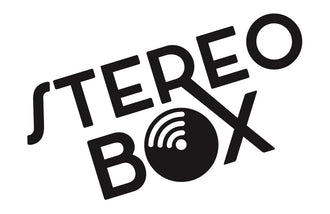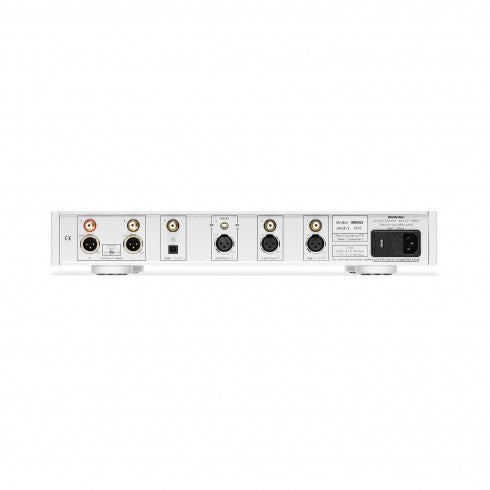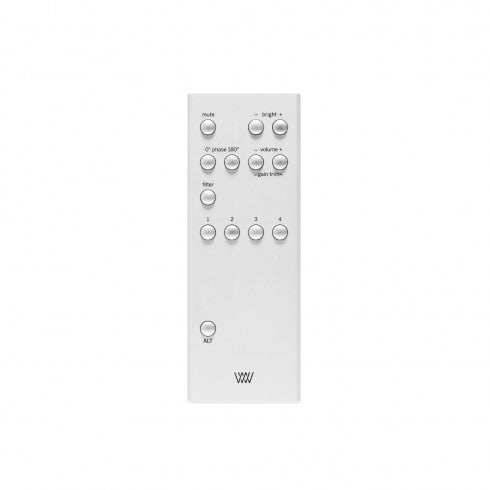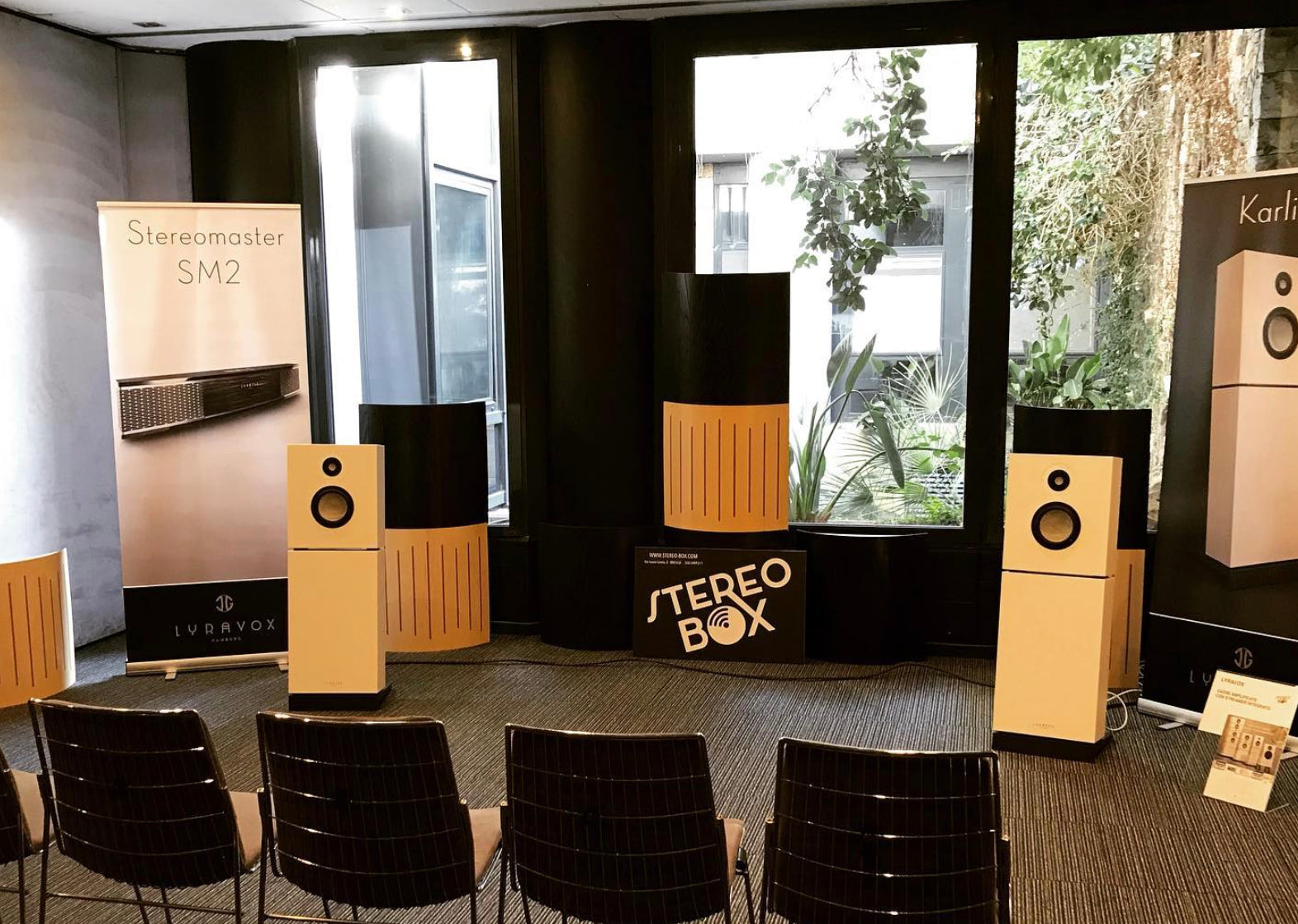MEDUS has its origins in our product line for professional mastering studios. Mastering engineers have golden ears to give recordings the finishing touches before their release. So MEDUS is as transparent as possible. It puts the Get your hands on the best Digital to Analog Converter money can buy.
MEDUS is a 24-bit/192 kHz stereo digital-to-analog converter designed with the goal of maintaining an absolutely uncompromising audio signal path. Much thought and detail has gone into both the digital input and the analog output stage. Both have in common the purest possible approach to audio design, aspiring to nothing less than excellence. Add to this an ergonomic design that gives the user immediate access to all necessary functions, while maintaining a clean and therefore easy-to-use front panel. This combination makes for a truly professional D/A converter that meets the highest expectations.
MEDUS works with AES/EBU, S/DIF, USB and Firewire (optional) inputs and handles PCM and DSD signals. An infrared remote unit controls all functions.
Main features
Mechanics
The MEDUS uses a double metal frame. The inner frame is made of steel and acts as a very effective shield against electrostatic and electromagnetic radiation. The outer frame is made of solid anodized aluminum for additional shielding, optimal heat convection and a pleasant appearance.
Diet
A powerful non-switching power supply is used. All sensitive voltages have their own regulators that are separated between the left and right channels. The result is an analog output free of "digital noise" and channel crosstalk. The power switch activates a semiconductor relay that only switches on or off at zero crossings of the mains voltage. This ensures trouble-free power switching. The mains transformer is located in a metal shielding box.
Synchronization
The MEDUS is synchronized by the input signal present on the selected input. Several signal re-clocking schemes are combined for extremely high jitter attenuation down to subsonic frequencies, making the MEDUS virtually immune to jitter. With USB or Firewire inputs the master clock is generated by the MEDUS.
Digital inputs
There are a total of four inputs with the following input jacks:
- Input #1: AES/EBU over XLR or RCA
- Input #2: AES/EBU over XLR or RCA
- Input #3: AES/EBU over XLR or USB
- Input #4: AES/EBU over TOSLINK or RCA
Sample rates can be 44.1, 48, 88.2, 96, 176.4, or 192 kHz. Inputs #1 and #2 can be used for the two-wire scheme for data transfer from 88.2 kHz to 192 kHz. All inputs accept up to 24 bits of data string length. Optional inputs are Firewire or ST-type fiberglass.
Up Sampling
Signals at a sampling rate of 44.1 or 48 kHz are upsampled in the MEDUS DSP chip using our upsampling algorithms. This ensures that the DAC chip always receives signals at a minimum sampling rate of 88.2 kHz.
Converters
The 32-bit DAC chip oversamples the input signal to approximately 1.5MHz. Four channels of D/A conversion are used for each audio channel, resulting in exceptional performance. The I/V conversion after the DAC chip uses two of our discrete OP-AMPs (OP1-BP) per channel.
Analog outputs
All analog processing is done with our discrete operational amplifier modules, the Weiss OP1-BP. The OP1-BP is probably the best audio operational amplifier currently available. Four OP1-BPs are used per channel, two for the current-to-voltage (I/V) conversion and two for the balanced and unbalanced output stages. The OP1-BPs operate in class A for all common loads. The output levels can be set with a rotary switch on the back of the unit. The level range is 32 dB with a step resolution of 1 dB. The outputs are symmetrical on the XLR connectors and asymmetrical on the RCA connectors. No servo degrading mechanisms or AC coupling capacitors are used.
Front Panel Controls
The power switch turns the MEDUS on or off. Four switches select one of four input sources. A display provides information on the selected input, sampling rate, output level, oversampling filter type, absolute output polarity, mute status, and approximate output level setting.
Remote control
It allows you to control all the functions of MEDUS, in particular: The input selected for conversion, the output level, the output muting, the approximate output level, the absolute polarity, the type of oversampling filter, the display brightness.
Rear panel elements from left to right
- Analog outputs on XLR and RCA connectors with output level switch.
- Digital inputs 1....4 (three XLR, three RCA, one USB and one TOSLINK connector).
- Mains connector with fuses and voltage selector.
Optional rear panel elements
- Firewire connector.
- ST type glass fiber connector.
INT204 USB/DSD Interface
The Weiss Engineering INT204 is a USB to AES/EBU (unidirectional) interface that also handles DSD to PCM conversion. DSD files played on the INT204 are converted to PCM at a preset sample rate and bit rate. This turns your trusty D/A converter into a DSD-capable DAC.
Your favorite DAC may not be the latest one on the market but you like the sound, the look and the features. So you don't want to buy another expensive DAC just to plug it into a computer.
This is where our interfaces come in. The INT204 allows any DAC to be connected to a computer with a USB port. This is done, optimally, by slaved the computer's clock to the internally generated clock of the INT204.
The INT204 is a USB to AES/EBU (unidirectional) interface that also handles DSD to PCM conversion. DSD files played on the INT204 are converted to PCM at a selectable sample rate and bit rate. This turns your trusty D/A Converter into a DSD-capable DAC.
Additionally, the INT204 can function as a digital volume control device, controlled by an infrared remote unit.
Main features
Mechanics
The INT204 is housed in a silver anodized aluminum chassis.
Diet
The INT204 requires two power sources. One is the bus power supplied via the USB connector, the other is an external power supply that is supplied with the INT204. This scheme allows the input and output sections of the INT204 to be galvanically isolated.
Synchronization
The sampling rate is generated with an internal generator in the INT204. This ensures that the transfer between the computer and the D/A converter is low jitter.
Digital input
A USB Type-B connector is used to connect to the computer.
Digital outputs
There is an XLR jack, a BNC jack and an RCA jack. The BNC and RCA jacks are driven by the same driver chip.
Front Panel Controls
There are eight LEDs for displaying the sampling rate and power status. A switch allows you to select the sampling rate when converting from DSD to PCM (176.4 or 88.2 kHz). Another switch selects the string length when converting from DSD to PCM (24 or 16 Bit). A power switch manages the on/off for the external power input.
Rear panel elements from left to right
There is a power socket for external power supply, USB connector, three output connectors (BNC, RCA, XLR).
Software Features
The INT204 can perform DSD to PCM conversion at selectable sampling rates and string lengths (88.2 or 176.4 kHz and 16 or 24 Bit). The DSD input is in DoP format with a sampling rate of DSD64 (2.8224 MHz) or DSD128 (5.6448 MHz).
The supported PCM sampling rates are all standard rates between 44.1 kHz and 384 kHz. The sampling rate of 352.8 kHz is automatically converted to 176.4 kHz, and the sampling rate of 384 kHz is converted to 192 kHz, since AES/EBU or S/PDIF formats do not support sampling rates higher than 192 kHz.
Remote control
As an option, you can purchase an infrared remote control to control the audio volume in the digital domain.
Technical specifications
Power
- External power supply, the required value is 6....9V at 0.15A
Size
- Depth: 16.5 cm
- Width: 10.5 cm
- Height: 4.4 cm
- Height with feet: 4.7 cm
Available color
- Silver
Digital input
- (1) USB Type B connector
Digital outputs
- BNC connector
- RCA connector
- XLR connector
- String length up to 24 bits
- Supported sampling rates: 44.1 kHz, 48 kHz, 88.2 kHz, 96 kHz, 176.4 kHz, 192 kHz
Synchronization
- The sampling rate is generated internally
- Supported sampling rates: 44.1 kHz, 48 kHz, 88.2 kHz, 96 kHz, 176.4 kHz, 192 kHz, 352.8 kHz, 384 kHz, DSD64, DSD128
DSP Algorithms
- Conversion from DS64 or DSD128 to PCM at 88.2 kHz or 176.4 kHz and 16 bit or 24 bit.
- Conversion from 352.8kHz to 176.4kHz and from 384kHz to 192kHz
- Infrared controlled volume control with dithering for optimal audio quality
Optional cards
| Medus USB / DS input option |
€2,350.00 |
| Medus Ethernet input option | €2,650.00 |
| Medus Firewire input option | €1,970.00 |
| Medus Glass Fiber input option (ST) | €1,010.00 |





